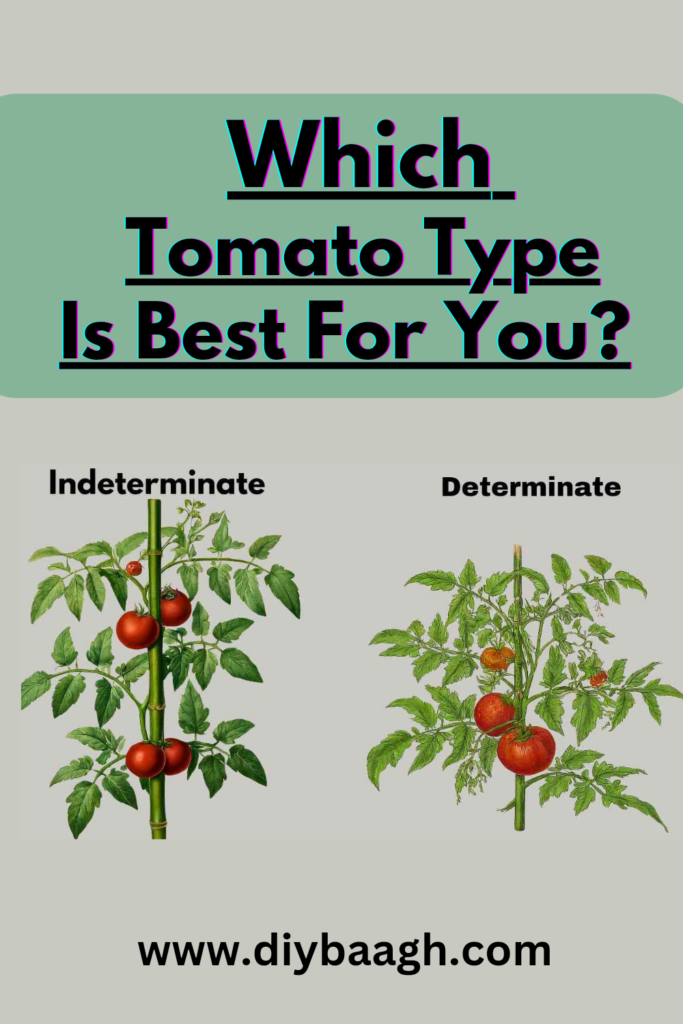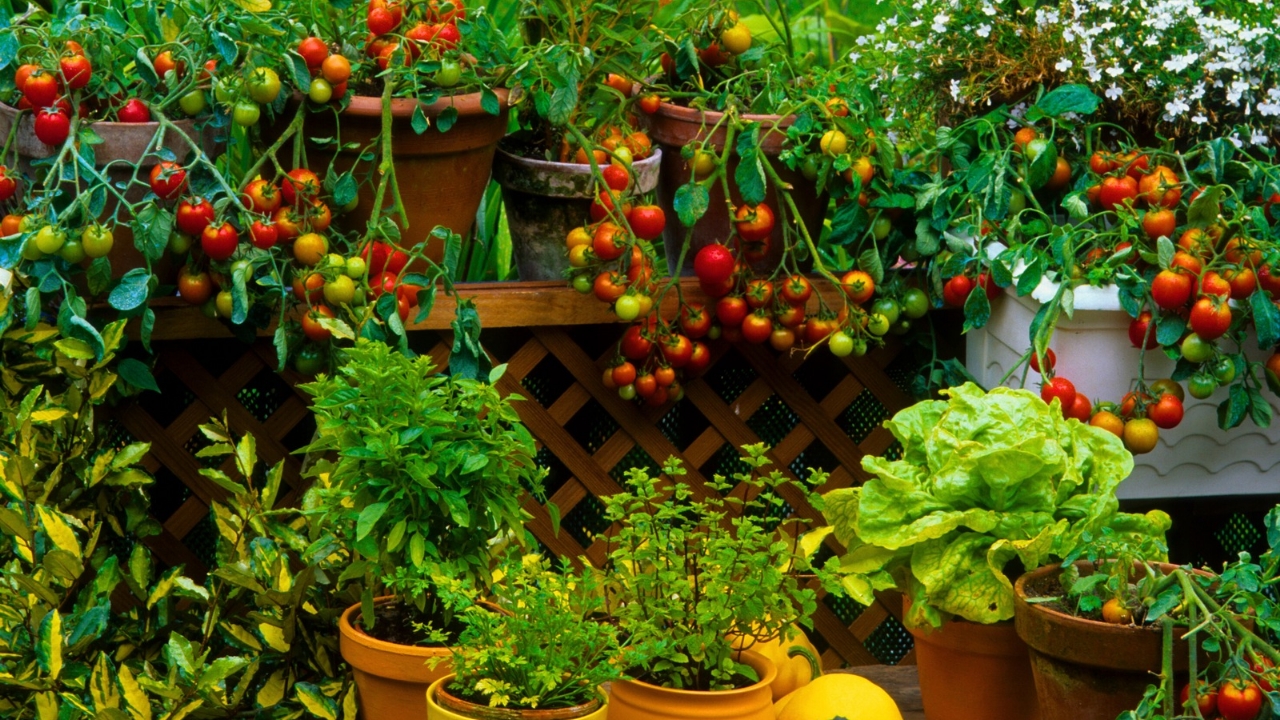Difference Between a Determinate and an Indeterminate Tomato:
There are so many kinds of tomatoes that it can be hard to decide which one to buy. The length of your growth season is one of the first things you should think about.
Tomato cultivars that are determined mature early.
When it comes to tomato kinds, indeterminate types will grow for longer and bear fruit until the first frost.
What You Need to Know About Determinate and Indeterminate Tomatoes?

To grow tomatoes successfully, you need to understand the main differences between indeterminate and determinate types. This information is very important for getting the most out of your plant’s growth and yield.
Indeterminate Tomatoes:
These are vine-growing types of tomatoes that keep growing until they are killed by frost or disease. At the leaf tips, they make suckers that can grow into new stems. To keep growth under control, pruning is often suggested.
Determined Tomatoes:
These are bush-like plants that grow to a set height. For flowers and food, they depend on suckers. Pruning these plants can make them produce much less.Certain tomatoes ripen all at once, and the plant dies after the gathering. They only get about 4 feet tall, so they don’t take up much room in the yard and look great in pots.The majority of sauce tomato types are fixed. Since the whole crop ripens at once, you can make a lot of sauce, can it, and put it in jars.
How to Do Proper Pruning?

To get a big supply, you need to make sure that the way you prune your tomatoes is right for the type of tomato you’re growing.
Determinate Tomatoes:
When you prune, only get rid of the leaves and suckers below the first flower cluster.
If it’s not necessary to deal with disease or plant height problems, don’t prune after the first flower cluster appears.
Indeterminate Tomatoes:
Refer to specific pruning tutorials for guidance on managing sucker growth and plant structure.
The Mistakes of Pruning:
People who garden often make the mistake of trimming all tomato plants the same way. This could be very bad for your tomato crop.
Indeterminate trimming: As we already said, trimming can help indeterminate tomatoes control their growth.
Determinate trimming: On the other hand, pruning determinate tomatoes can greatly lower the number of fruits they produce. For these plants to make flowers and then tomatoes, they need suckers.
What Kind of Tomato Should I Grow?

There are pros and cons to both determinate and indeterminate tomato types. Decide what kind of tomato you want to grow based on how you plan to use them and how long your growth season is.
Let’s say you want to make sauce with tomatoes. Decided tomatoes have fewer seeds and more meat. Also, they do well in places with short growing seasons of only a few months.
So you can eat fresh veggies all season, and grow tomatoes that don’t die. There are some short-season indeterminate types that do well where the growing season is short.
Types of Determinate and Indeterminate Tomatoes That Grow Well:
You could grow these determinate and indeterminate tomatoes in your yard.
- Celebrity: This hybrid globe tomato is really a celebrity. It gets 3 to 4 feet tall. From planting to frost, it takes 70 days for the fruit to grow to be about 8 to 10 ounces.
- San Marzano Nano: This tomato plant stays small enough to handle, unlike other San Marzano tomato plants. The Roma-style original plum tomato is a cooking tomato that is juicy and full of flavor.
- Amish Paste: This traditional pear tomato is about the size of a fist and weighs 8 to 12 ounces. It tastes sweet. It’s great for slicing, cooking, and canning. After the harvest, save the seeds to plant again the next year.
- Marglobe: This heirloom fruit is ready to eat after 75 days, and its meat is firm and doesn’t bruise or crack easily.
- Rutgers: This tomato plant has a big early crop of tasty, disease-resistant fruit, and then it has several more blooms during the season.
Indeterminate Varieties
Most tomato types sold in plant centers are indeterminate. This includes heirloom, cherry, and dwarf tomato types. “Beefsteak,” “Big Boy,” “Brandywine,” “Sungold,” and “Sweet Million” are some of the most famous indeterminate tomatoes.
Early-producing types, like “Early Girl,” are also not certain. This kind grows up and dies back earlier, and it’s also known as semi-determinate.
You might also want to grow the following Indeterminate hybrids:
- Big Beef: Another beefsteak tomato that bears fruit 10 to 12 ounces in weight 73 days after planting.
- Big Boy: About 78 days after planting, this tomato plant bears fruit that is 10 to 16 ounces in weight.
- Early Girl: About 50 to 52 days after planting, this globe tomato bears fruit that is about 8 ounces in weight.
- Juliet: This mutant cherry tomato is long, and it bears 1-ounce fruit about 60 days after planting.
- Sun Sugar: About 62 days after growing, this cherry tomato bears a 1-ounce orange-yellow fruit.
- Better Boy: About 75 days after planting, this beefsteak tomato bears fruit that is 10 to 16 ounces in weight.
Using trellising

I already said that fixed and indeterminate tomatoes need different kinds of trellising. Some tomatoes don’t need a trellis at all, while determinate tomatoes are easier to train. If you don’t trellis indeterminate tomatoes, they get wild and messy, and it takes a little more work to get them to grow in a neat shape.
Because determinate tomatoes stay short, less than four feet, a wire tomato cage is an easy way to keep them in place and support them. You could also put three or four wooden sticks about eight inches from the plant’s base. Set up a triangle with three stakes and a square with four stakes. Wrap twine around the poles as the plant grows to support it and box in the growth.
You can support indeterminate tomatoes with tomato cages, but the plants will finally grow too big for the cage and fall over the top. A cow panel or the stake and weave method are both better ways to make a trellis. If you have a cattle panel, you can use twine or plastic trellising clips to connect the vine to it.
For two plants in a yard or hundreds of plants in a field, the stake and weave method can be used. There have been farms and community garden spots where I’ve used it. It works best for tomatoes that are grown in a row, though.
- Place a wooden stake or metal t-post about six inches from the base of each side of your tomato plant. The posts need to be at least six feet tall, but eight feet is better. Every three plants in a row should have a stake put in them.
- Drive the posts six to eight inches into the ground with a mallet or post-pounder.
- When the plants are six inches tall, it’s time to put up stakes. Tomato string should be tied to one stake and then run along the side of the plants to the other stake. Pull the twine tight and tie it again. The wire should be eight inches above the ground. On the other side of the plant, do this step. The tomato plant should sit between two pieces of yarn when you’re done.
- You should add another piece of twine eight to ten inches above the first one when the plants are about a foot above it.
- Do this again and again as your plant grows until the twine reaches the top of the stakes. It’s okay that the vines will grow over the twine.
Conclusion
You can greatly increase your tomato yield by learning the differences between indeterminate and determinate tomatoes and using the right pruning methods. Before you decide how to prune your tomato plants, you should always check the seed packet or variety description to see what kind of tomato you are growing.
Remember that if you want your tomato garden to do well, you need to give it the care and attention it needs.
FAQ
Which is better, a determinate or indeterminate tomato plant?
A determinate tomato is better for making sauces, while an indeterminate tomato is better for eating fresh as a snack or sliced all season long. Which one you choose will rely on how you plan to use the tomatoes and how long your growing season is.
What are the best-tasting indeterminate tomatoes?
“Beefsteak,” “Big Boy,” “Brandywine,” “Sungold,” and “Sweet Million” are some of the most popular indeterminate tomatoes to grow.
Do you need to prune indeterminate tomatoes?
Yes, you need to prune indeterminate tomato plants. It takes a long time for these tomato plants to grow a lot of leaves. By pruning, you can send more energy to making fruits instead of leaves, and you can let more sunlight reach the fruits on the vine to make them ripe.
How tall should I allow my indeterminate tomatoes to grow?
Some types of indeterminate tomatoes can grow up to 10 feet tall or even more. Support structures can help them spread out instead of growing up if they’re hard to reach or keep track of. You can also cut off the tops, but some of the fruit will be lost.

